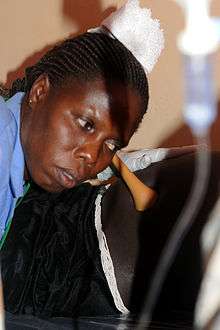Pinard horn
A Pinard horn is a type of stethoscope used to listen to the heart rate of a fetus during pregnancy. It is a hollow horn, often made of wood or metal, about 8 inches (200 mm) long. It functions similarly to an ear trumpet by amplifying sound. The user holds the wide end of the horn against the pregnant woman's abdomen, and listens through the other end.[1]

History
The Pinard horn was invented by Dr. Adolphe Pinard, a French obstetrician, during the 19th century.[1] Pinard was an early supporter of advancements in prenatal care, including closer fetal health monitoring.[2]
Current use
Pinard horns continue to be used around the world, particularly by midwives, but also by doctors and nurses. Pinard horns are the most common fetal stethoscopes in much of Europe in contrast to the United States, where a Doppler fetal monitor is standard.[3] It provides an alternative to more expensive Doppler. Another alternative is the fetoscope, which is a stethoscope designed for auscultating fetuses. A midwife in Mexico describes using the Pinard horn:
Sometimes we listen to the fetal heart rate with the Pinard, but if the woman is very sensitive, and it bothers her to push into her belly with the Pinard horn, then we use the Doppler. But the Doppler often transmits a lot of noise; it gets confusing. So better with the Pinard.[4]
A Pinard horn may be used to determine the position of the fetus. A Pinard horn is more precise than a Doppler device for this purpose. A Doppler device detects a heart tone farther away from the location of origin. A Pinard horn must be pressed to a location very close to the fetal heart in order to detect it, providing a more accurate indication of fetal position. A doctor, nurse, or midwife can also use palpation and auscultation to determine fetal position.[5]
See also
- Doppler ultrasound
- Fetal heart rate
- Fetoscopy
References
- Robbie Davis-Floyd; Carolyn Fishel Sargent (1997). Childbirth and Authoritative Knowledge: Cross-Cultural Perspectives. University of California Press. pp. 360. ISBN 9780520207851.
- Baker, Jeffrey P. (1996). The Machine in the Nursery: Incubator Technology and the Origins of Newborn Intensive Care. Johns Hopkins University Press. p. 58. ISBN 9780801851735.
- Ina May Gaskin; Ani DiFranco (2011). Birth Matters: A Midwife's Manifesta. Seven Stories Press. pp. 112–3. ISBN 9781583229279.
- Robbie Davis-Floyd; Lesley Barclay; Jan Tritten (2009). Birth Models that Work. University of California Press. p. 310. ISBN 9780520248632.
- Penny Simkin; Ruth Ancheta (2011). The Labor Progress Handbook: Early Interventions to Prevent and Treat Dystocia. John Wiley & Sons. p. 61. ISBN 9781444337716.
